
Sahure was a king of ancient Egypt and the second ruler of the Fifth Dynasty. He reigned for around 13 years in the early 25th century BC during the Old Kingdom Period. Sahure's reign marks the political and cultural high point of the Fifth Dynasty. He was probably the son of his predecessor Userkaf with Queen Neferhetepes II, and was in turn succeeded by his son Neferirkare Kakai.

Abu Gorab is a locality in Egypt situated 15 km (9.3 mi) south of Cairo, between Saqqarah and Al-Jīzah, about 1 km (0.62 mi) north of Abusir, on the edge of the desert plateau on the western bank of the Nile. The locality is best known for the solar temple of King Nyuserre Ini, the largest and best preserved solar temple, as well as the solar temple of Userkaf, both built in the 25th century BCE during the Old Kingdom Period. Evidence suggests that as many as six solar temples were constructed during the 5th Dynasty, however, only the two temples previously mentioned have been excavated. Abu Gorab is also the site of an Early Dynastic burial ground dating back to the First Dynasty.
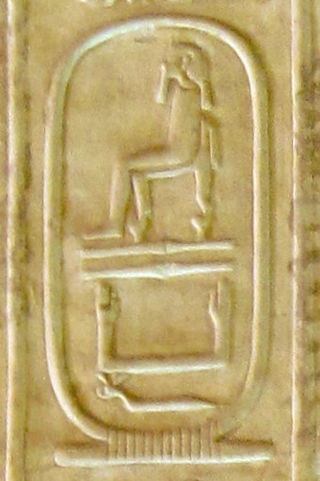
Shepseskaf was a pharaoh of ancient Egypt, the sixth and probably last ruler of the fourth dynasty during the Old Kingdom period. He reigned most probably for four but possibly up to seven years in the late 26th to mid-25th century BC.

Userkaf was a king of ancient Egypt and the founder of the Fifth Dynasty. He reigned for around seven years in the early 25th century BC, during the Old Kingdom period. He probably belonged to a branch of the Fourth Dynasty royal family, although his parentage is uncertain; he could have been the son of Khentkaus I. He had at least one daughter and very probably a son, Sahure, with his consort Neferhetepes. This son succeeded him as king.

Neferirkare Kakai was an ancient Egyptian pharaoh, the third king of the Fifth Dynasty. Neferirkare, the eldest son of Sahure with his consort Meretnebty, was known as Ranefer A before he came to the throne. He acceded the day after his father's death and reigned for around 17 years, sometime in the early to mid-25th century BCE. He was himself very likely succeeded by his eldest son, born of his queen Khentkaus II, the prince Ranefer B who would take the throne as king Neferefre. Neferirkare fathered another pharaoh, Nyuserre Ini, who took the throne after Neferefre's short reign and the brief rule of the poorly known Shepseskare.

Menkauhor Kaiu was an Ancient Egyptian king of the Old Kingdom period. He was the seventh ruler of the Fifth Dynasty at the end of the 25th century BC or early in the 24th century BC.

Neferefre Isi was an ancient Egyptian king of the Fifth Dynasty during the Old Kingdom period. He was most likely the eldest son of king Neferirkare Kakai and queen Khentkaus II. He was known as prince Ranefer before he ascended to the throne.
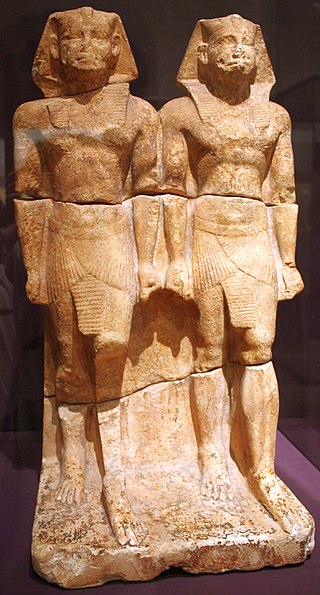
Nyuserre Ini was an Ancient Egyptian king, the sixth ruler of the Fifth Dynasty during the Old Kingdom period. He is credited with a reign of 24 to 36 years depending on the scholar, and likely lived in the second half of the 25th century BCE. Nyuserre was the younger son of Neferirkare Kakai and queen Khentkaus II, and the brother of the short-lived king Neferefre. He may have succeeded his brother directly, as indicated by much later historical sources. Alternatively, Shepseskare may have reigned between the two as advocated by Miroslav Verner, albeit only for a few weeks or months at the most. The relation of Shepseskare with Neferefre and Nyuserre remains highly uncertain. Nyuserre was in turn succeeded by Menkauhor Kaiu, who could have been his nephew and a son of Neferefre.

Shepseskare or Shepseskara was an Ancient Egyptian king, the fourth or fifth ruler of the Fifth Dynasty during the Old Kingdom period. Shepseskare lived in the mid-25th century BC and was probably the owner of an unfinished pyramid in Abusir, which was abandoned after a few weeks of work in the earliest stages of its construction.

Abusir is the name given to an ancient Egyptian archaeological pyramid complex comprising the ruins of 4 kings' pyramids dating to the Old Kingdom period, and is part of the Pyramid Fields of the Memphis and its Necropolis UNESCO World Heritage Site.

Khentkaus II was a royal woman who lived in ancient Egypt. She was a wife of Egyptian king Neferirkare Kakai of the Fifth Dynasty. She was the mother of two kings, Neferefre and Nyuserre Ini.

The pyramid of Neferirkare was built for the Fifth Dynasty pharaoh Neferirkare Kakai in the 25th century BC. It was the tallest structure on the highest site at the necropolis of Abusir, found between Giza and Saqqara, and still towers over the necropolis. The pyramid is also significant because its excavation led to the discovery of the Abusir Papyri.

The pyramid of Sahure is a pyramid complex built in the late 26th to 25th century BC for the Egyptian pharaoh Sahure of the Fifth Dynasty. It introduced a period of pyramid building by Sahure's successors in Abusir, on a location earlier used by Userkaf for his sun temple. The site was first thoroughly excavated by Ludwig Borchardt between March 1907 and 1908, who wrote the standard work Das Grabdenkmal des Königs Sahu-Re between 1910 and 1913.

The pyramid of Neferefre, also known as the pyramid of Raneferef, is a 25th century BC unfinished pyramid complex built for the Egyptian pharaoh Neferefre of the Fifth Dynasty. Neferefre's unfinished pyramid is the third and final one built on the Abusir diagonal – a figurative line connecting the Abusir pyramids with Heliopolis – of the necropolis, sited south-west of Neferirkare's pyramid.
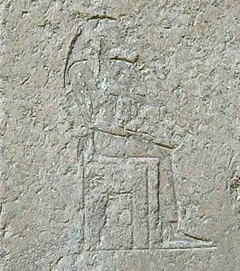
Khentkaus I, also referred to as Khentkawes, was a royal woman who lived in ancient Egypt during both the Fourth Dynasty and the Fifth Dynasty. She may have been a daughter of king Menkaure, the wife of both king Shepseskaf and king Userkaf, the mother of king Sahure.
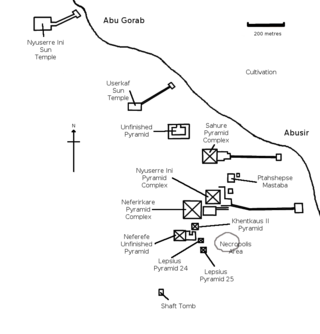
The Abusir Papyri are the largest papyrus findings to date from the Old Kingdom in ancient Egypt. The first papyri were discovered in 1893 at Abu Gorab near Abusir in northern Egypt. Their origins are dated to around the 24th century BC during the Fifth dynasty of Egypt, making them, even though often badly fragmented, among some of the oldest surviving papyri to date. Later on, a large number of additional manuscript fragments were discovered in the area.
Rededjet is the name of a fictitious ancient Egyptian woman appearing as the heroic character in a story told in the legendary Westcar Papyrus. She is said to have fulfilled a prophecy by giving birth to three future kings that was forecast during the reign of Khufu by a magician named Dedi.
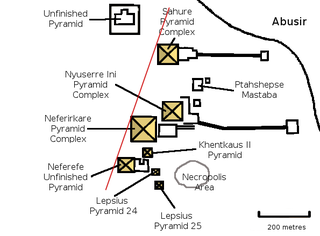
The unfinished pyramid of Abusir is an abandoned pyramid complex located in the necropolis of Abusir whose construction began in the Fifth Dynasty. It is speculatively assigned to Shepseskare, an ephemeral pharaoh whose brief rule is the least well documented of the Fifth Dynasty.
The Sun Temple of Userkaf was an ancient Egyptian temple dedicated to the sun god Ra built by pharaoh Userkaf, the founder of the Fifth Dynasty of Egypt, at the beginning of the 25th century BCE. The sun temple of Userkaf lies between the Abusir pyramid field to the south and the locality of Abu Gorab to the north, some 15 km (9.3 mi) south of modern-day Cairo. The ancient name of the temple was Nekhen-Re meaning the "Stronghold of Ra". The temple complex comprised several parts: on a low hill situated on the desert edge was the main temple which could be accessed via a causeway from a valley temple, located nearer to the area of cultivation and the Nile.

The pyramid of Nyuserre is a mid-25th-century BC pyramid complex built for the Egyptian pharaoh Nyuserre Ini of the Fifth Dynasty. During his reign, Nyuserre had the unfinished monuments of his father, Neferirkare Kakai, mother, Khentkaus II, and brother, Neferefre, completed, before commencing work on his personal pyramid complex. He chose a site in the Abusir necropolis between the complexes of Neferirkare and Sahure, which, restrictive in area and terrain, economized the costs of labour and material. Nyuserre was the last king to be entombed in the necropolis; his successors chose to be buried elsewhere. His monument encompasses a main pyramid, a mortuary temple, a valley temple on Abusir Lake, a causeway originally intended for Neferirkare's monument, and a cult pyramid.


















